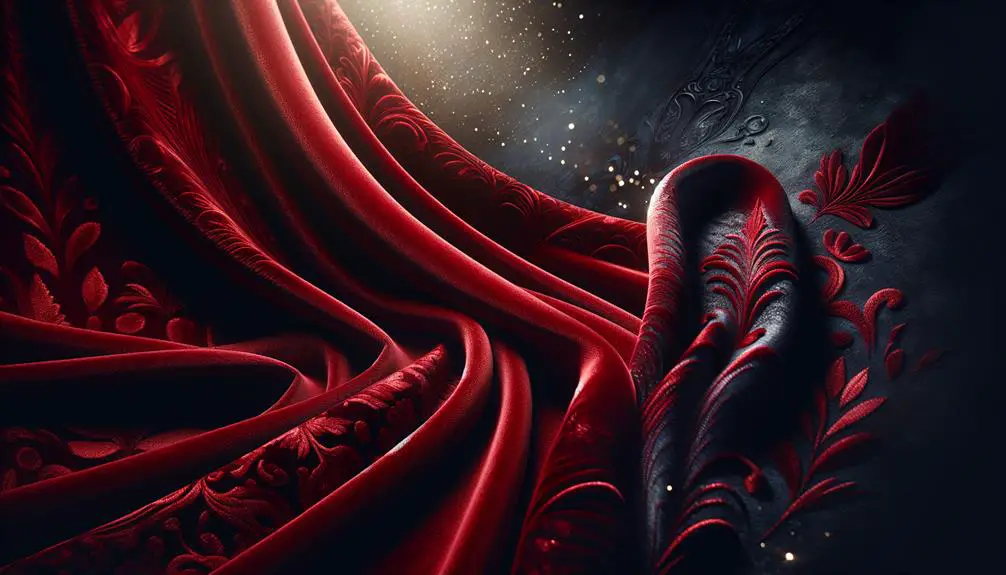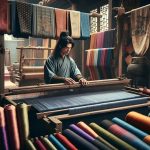I've always been fascinated by velvet, not just for its luxurious feel but also for its complex history. Did you know that its journey began in ancient Egypt? It's intriguing how it symbolized wealth and power back then and still manages to hold a similar prestige today. I'm curious about how this fabric has continuously adapted to various cultural and fashion trends over the centuries. There's a lot to unpack about its production techniques and its role in modern sustainability efforts. Let's explore what makes velvet so enduring and versatile, shall we?
Table of Contents
Key Takeaways
- Velvet features a unique luxurious texture due to its specialized double-cloth weaving process.
- It offers a rich, deep coloration that enhances its visual appeal.
- Historically, velvet has been a symbol of wealth and power, adding to its special status.
- Velvet is versatile, used in both high fashion and elegant home decor.
- Innovations in production, such as digital weaving, have modernized velvet while maintaining its classic luxury.
The Origins of Velvet
Velvet's rich history began in ancient Egypt, where it was first woven by skilled artisans. It wasn't just fabric; it was a symbol of wealth and power. As I explore this luxurious material's past, it's clear that its journey through various cultures added layers of meaning and value.
From Egypt, velvet spread along trade routes to the East and West. These velvet trade routes weren't just about commerce but also cultural exchange. Every region it touched, it was embraced and integrated into local customs, becoming a part of their cultural symbolism.
In medieval Europe, velvet became synonymous with nobility. Only the wealthy could afford its lush, textured feel. It was a status symbol, worn by kings and queens. This association with power made velvet even more desirable.
Moving East, in places like China and the Byzantine Empire, velvet was equally revered, often used in religious and imperial contexts. Its texture and sheen were seen as fitting for gods and rulers.
Understanding these roots, it's clear that velvet was never just a fabric. It was a carrier of status, an item of trade, and a treasure of cultures. Each thread of velvet carries stories of opulence, power, and a mingling of worlds.
How Velvet Is Made
How do artisans transform simple threads into the luxurious fabric known as velvet? They use specialized velvet weaving techniques, primarily a unique double-cloth process where two layers of fabric are woven simultaneously. Here's how it rolls: two sets of warp threads are used— one for the pile and one for the backing. As they weave, blades slide between the layers to cut the threads, creating velvet's signature soft pile.
This process isn't quick. It's meticulous, demanding precise tension and careful handling to make certain the pile stands upright and uniformly. That's where the expertise of seasoned weavers shines. They've got this down to an art, but it's labor-intensive, which ramps up velvet production costs.
Materials also play a big part. High-quality natural fibers like silk increase cost but improve the fabric's feel and durability. Cheaper synthetic fibers are an option, but they affect the texture and wearability. It's a fine balance between quality and expense.
Every yard of velvet reflects hours of skilled labor and costly resources. That's why it's pricier than many other fabrics and why its lush, rich texture feels like a luxury against the skin.
Types of Velvet
Velvet comes in several distinct types, each with its own texture and shine. Let's explore a few popular ones and how they fit into today's velvet market trends.
First up, there's silk velvet, the crème de la crème, known for its luxurious feel and deep coloration. It's the softest type you can find, making it a top pick for high-end products. The demand for this type reflects its status as a premium choice in velvet weaving techniques.
Then, there's cotton velvet, which is more matte but incredibly durable. It's less pricey than silk, making it more accessible and popular for home decor. It's interesting how its practicality has kept it firmly in the market trends, adapting well to various uses without losing its appeal.
Synthetic velvets, like polyester, are also worth noting. They've gained traction because they offer similar aesthetics to natural fibers but at a lower cost and with greater durability. The development in synthetic velvet weaving techniques has revolutionized its quality, influencing its rising popularity in the velvet market.
Each type has its niche, defined by its unique properties and the advancements in weaving techniques that cater to evolving market trends.
Velvet in Fashion
Exploring the types of velvet, I'm now shifting my focus to its role in fashion. Velvet has a profound impact on fashion, with its rich texture and depth providing a unique aesthetic that's hard to match. I've noticed that velvet doesn't just add a touch of luxury; it sets trends. Let's delve into how velvet shapes the fashion world.
Velvet runway trends often dictate the season's mood. From plush jackets to elegant gowns, designers use velvet to make bold statements. These pieces catch the light uniquely, creating a visual spectacle that's perfect for high-fashion moments.
Celebrity velvet outfits have also spotlighted this material. When a star steps out in velvet, it often becomes headline news. These outfits range from sophisticated suits at premieres to stunning dresses at award shows. They not only showcase velvet's versatility but also its timeless appeal.
Here are some key insights into velvet in fashion:
- Luxury and Comfort: Velvet is preferred for its luxe look and soft feel.
- Seasonal Versatility: It's not just for winter; lighter velvet is popular in warmer months.
- Color Richness: Velvet's depth enhances colors, making them more vibrant and noticeable.
Clearly, velvet's role in fashion is both influential and enduring.
Velvet in Home Decor
Now, let's talk about how velvet plays a role in home decor.
It's amazing how the textures of velvet can boost the comfort of any room.
Plus, using velvet in different colors can really make your space pop.
Velvet Textures Enhance Comfort
Many homeowners find that incorporating velvet textures into their decor greatly enhances the comfort level of their living spaces. There's a unique allure to velvet, primarily due to its softness and the way it invites us to relax and feel at ease immediately.
Here's why velvet is a top choice for boosting comfort:
- Velvet softness provides a tactile experience that's both soothing and luxurious.
- Velvet's dense pile helps in retaining warmth, making any room feel more cozy.
- Regular velvet cleaning is straightforward and keeps the fabric looking fresh, enhancing the overall feel of your space.
I've noticed that my velvet-covered cushions and curtains make the living room not just visually appealing, but also incredibly snug and inviting.
Color Impact With Velvet
Velvet truly transforms a room with its rich colors that add depth and luxury to any space. When I choose velvet for home decor, I'm not just picking a fabric; I'm selecting a mood. Color psychology plays a big role here. Deep blues convey calmness, making them perfect for bedrooms. Vibrant reds, on the other hand, bring energy to living spaces.
What's fascinating about velvet is its ability to show off shade variation. Depending on the light, the same piece can look subtly different at various times of the day. This dynamic quality keeps the decor fresh and engaging. Honestly, incorporating velvet is like adding a living, breathing element to your home. It's all about setting the right tone.
Caring for Velvet
Caring for velvet requires a gentle touch, as this delicate fabric can easily be damaged if not handled properly. I've learned that keeping velvet in tip-top shape is all about mastering a few key techniques, especially when it comes to stain removal and ironing.
When a spill happens, quick action is vital. I dab at stains with a soft cloth, using cold water to avoid setting the stain. It's tempting to rub, but that can ruin velvet's unique texture. For ironing, I never place the iron directly on velvet. Instead, I use a steamer or put a thick cloth between the iron and the fabric, and always keep the iron on a low heat setting. This method helps avoid crushing or scorching the fibers.
Here are a few more tips to keep your velvet looking luxurious:
- Avoid water rings by gently blotting spills without rubbing.
- Hang properly to avoid creases; use padded hangers if possible.
- Brush with a soft brush to maintain the fabric's soft, plush texture.
Mastering these care techniques means my velvet items stay lush and beautiful, ready for any occasion.
The Durability of Velvet
Despite its luxurious feel, velvet is surprisingly durable when cared for properly. You might think this soft fabric would be delicate, but it's tougher than it looks. Velvet resilience really comes into play when you consider how it holds up under pressure. I've seen velvet furniture that still looks great after years of use, which speaks volumes about its durability.
Let's talk about wear testing. When manufacturers want to see how tough their velvet is, they don't hold back. They subject it to rigorous tests, simulating years of use in just a few days. These tests are vital. They tell us exactly how much wear and tear the velvet can handle before it starts to show signs of distress.
Velvet Through the Ages
While we've explored how velvet stands up to wear, let's now delve into its fascinating history through different eras. Velvet's story is as rich and textured as the fabric itself, woven through with royal associations and deep cultural symbolism.
Here's a quick exploration into its past:
- Ancient Origins: Velvet was first crafted in the Far East. By the 14th century, it made its way to Europe through the Silk Road, turning into a symbol of wealth and power.
- Renaissance Luxury: In the Renaissance, velvet production flourished in Italy. Cities like Florence and Venice became famous for their high-quality velvet, often used in both fashion and furnishings by the aristocracy.
- Victorian Opulence: During the Victorian era, velvet became more accessible but retained its luxurious appeal. It was a staple in both home decor and fashion, symbolizing sophistication and status.
Each era saw velvet adapting to the cultural and fashion demands of the time while maintaining its allure among the elite. It's fascinating how this fabric has been a constant emblem of luxury and class, don't you think? The journey of velvet through history really shows its timeless appeal and adaptability.
Innovations in Velvet Production
Advancements in technology have revolutionized how we produce velvet today. It's not just about the plush feel anymore; it's how we get there that's really fascinating. Let me walk you through some of the coolest changes, especially in sustainable sourcing and digital weaving.
First off, sustainable sourcing has totally changed the game. We're now using eco-friendly materials that reduce environmental impact without compromising quality. Think organic cotton bases or recycled polyester. It's all about being kind to our planet while still creating gorgeous fabrics.
Now, onto digital weaving – this is where it gets super techy. Digital looms are precision-based geniuses that weave complex patterns and textures at speeds traditional methods can't touch. This not only speeds up production but also allows for intricate designs that were once deemed impossible.
Here's a quick look at how these innovations compare to traditional methods:
| Feature | Traditional Velvet | Sustainable Velvet | Digital Velvet |
|---|---|---|---|
| Material Source | Synthetic heavy | Eco-friendly | Varies |
| Production Speed | Slower | Moderate | Fast |
| Design Flexibility | Limited | Moderate | High |
| Environmental Impact | Higher | Lower | Depends on setup |
These innovations aren't just cool; they're reshaping what we expect from velvet. It's a blend of art and science, really.
The Future of Velvet
Exploring further, the future of velvet holds exciting possibilities in both fashion and functionality. As we transition into an era where sustainability and technology intersect, velvet isn't just staying put; it's poised to revolutionize. Let's delve into what we can anticipate:
- Velvet Recycling: We're upping the ante with velvet recycling initiatives. Picture repurposing old velvet garments into new, lavish items. This isn't just about cutting down on waste; it's about reimagining fashion sustainability.
- Velvet Digitalization: The digital realm is advancing rapidly, and velvet is no exception. From virtual fashion shows to digital textile printing, the incorporation of velvet in digital platforms is widening its reach and adaptability. Imagine purchasing a velvet dress online that you've virtually tried on!
- Innovative Uses Beyond Fashion: Velvet is pushing boundaries. Besides clothing, it's making a splash in home decor and automotive interiors. The opulent texture and depth it brings can truly elevate any space.
I'm fully onboard with these progressions. The fusion of traditional luxury with modern tech? Sign me up! With such advancements, velvet's future appears not only bright but truly dazzling.
Frequently Asked Questions
Can Velvet Be Dyed at Home Effectively?
Yes, I've dyed velvet at home successfully. The key is using the right dyeing techniques and ensuring good color retention. It's all about careful application and choosing dyes meant for velvet's unique texture.
Is Velvet Considered a Sustainable Material?
I've learned that velvet's sustainability largely depends on its production methods and recycling potential. Not all types are created equal, so it's important to choose options that prioritize environmental responsibility.
How Does Velvet React to Different Climates?
Velvet's not great with climate resilience. It absorbs moisture, so in humid or rainy climates, it'll feel heavier and might not dry quickly. I'd say it's better for cooler, dryer environments.
Are There Vegan Alternatives to Silk Velvet?
Yes, there are vegan alternatives to silk velvet. They typically involve synthetic or plant-based fibers, altering the fabric composition and production methods to avoid animal products while maintaining a similar luxurious feel.
Can Velvet Trigger Allergies or Skin Irritations?
Yes, velvet can sometimes trigger allergies or skin irritations, especially if you've got fabric sensitivities. The fibers might cause allergic reactions, so it's good to test if it bothers your skin first.
- How Does Ring Spun Cotton Affect Garment Fit and Shape Retention? - August 13, 2024
- What Are the Challenges in Producing Ring Spun Cotton? - August 13, 2024
- Is Ring Spun Cotton Suitable for Plus-Size Clothing? - August 13, 2024







